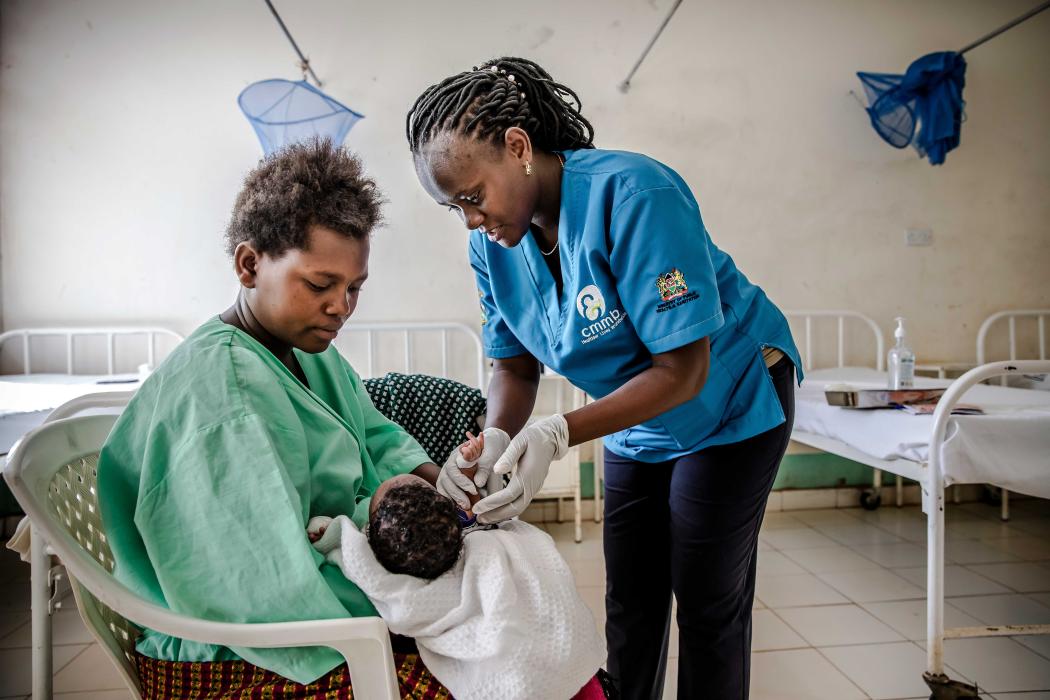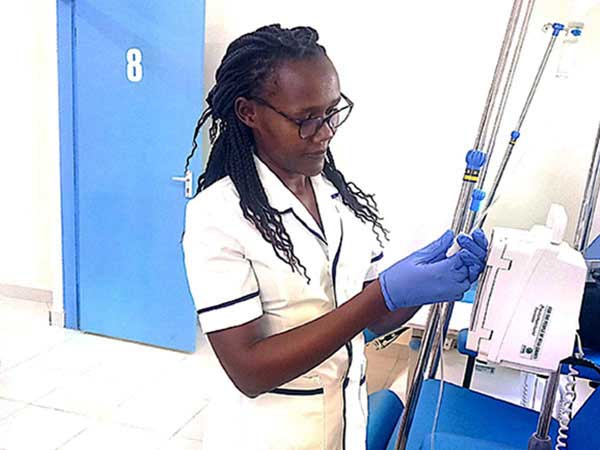What It Takes to Be a Health Worker

A CMMB-supported nurse attends to a new mother and her baby at the Ikanga Sub-County Hospital in Kitui South, Kenya. (Luis Tato/Getty Images for CMMB)
Theresia Mukethe understands demanding workloads, burnout, and high turnover of health workers in Kenya.
My journey into nursing began with a loss. Two decades ago, my beloved grandfather passed due to dementia and liver cirrhosis. Initially, I struggled to grasp the medical complexities that led to his passing and felt compelled to pursue a medical course. I wanted to learn more—I wanted to positively impact lives. Medical school became my aspiration, and I dedicated myself to studying diligently.
I understand the demands of being a health care professional firsthand. I practiced as a nurse for five years at a teaching and referral hospital in Kenya. My nursing career exposed me to serious health emergencies. I also saw many children under five seeking treatment for diarrhea, caused by the consumption of contaminated water. Common conditions in adults included everything from diabetes, hypertension, and liver failure to fractures and wounds.
I understand the demands of being a health care professional firsthand.
I know what it takes to be a health worker who desperately wants to deliver care but is limited due to a sheer lack of resources. During my tenure in the emergency department, I attended a patient who had sustained a head injury from a road traffic accident. The patient needed specialized care from a neurosurgeon, which our facility lacked. We had to refer him to a higher-level health facility.
Regrettably, the hospital ambulance was out of fuel and the patient's relatives could not afford to quickly cover the cost. It was 18 hours before the referral could be completed. Tragically, the patient's condition deteriorated, and he passed away. I remember the feeling of unease and constant worry. My heart sank when the patient passed away before receiving the essential care he urgently needed. As a nurse, I felt a profound sense of disappointment and unfulfillment, as the fundamental objective of saving lives was unmet.
Health workers cannot safely support patients if they themselves are not safe and supported.
Eventually, I transitioned my career into public health so that I could build strategies and interventions aimed at improving the health of entire communities. I also wanted to have a stronger role in advocacy for improved patient care through health systems strengthening.
Today, as a project officer at CMMB, I provide technical assistance to health workers and health management teams delivering care in Kenya’s most challenging contexts. In the communities where we work, non-communicable diseases are often untreated because patients cannot afford to sustain care—or the health facility has run out of the medication needed. Many mothers do not survive childbirth when complications arise because there aren’t enough trained health workers or hospitals lack the physical infrastructure, like functioning maternal and newborn wards.
We cannot achieve the progress we need without a safe and supported workforce.
I work to address these barriers to health, strengthen health service delivery, and reduce preventable loss of lives in Kenya’s Kitui South and Central sub-counties. But we cannot achieve the progress we need without a safe and supported workforce. That means health care professionals everywhere feel valued, respected, and empowered with the appropriate training and supplies to provide high-quality care—while prioritizing their own well-being.

Theresia Mukethe is a registered nurse and practiced for five years before transitioning her career to public health. Photo courtesy of Theresia Mukethe.
The challenges facing health workers have consequences that impact the quality of care their patients receive. For example, we know there is a critical shortage of health workers globally. The WHO estimates a gap of 10 million by 2030. In Kenya, the ratio of doctors, nurses, and midwives per 10,000 people lands way below the SDG index threshold.
I see high rates of burnout among health workers compromising patient care.
It is all too common for health workers in rural regions of Kenya to take on increasingly demanding workloads due to staff shortages. As a result, I see high rates of burnout among health workers compromising patient care. The shortage of human resources is compounded by stock outs of essential commodities and equipment. A health worker might be trained and willing to treat a patient but lacking the medicine or specialized tools needed to do so. This leads to low job satisfaction, staff turnover, and diminished well-being. The patient is left without the treatment they need.
In Kenya, strides are being made toward achieving universal health coverage thanks to the collaborative efforts of organizations like CMMB, alongside the support of both national and local governments. Through individual donors and trusted funding partners, CMMB invests in health training and continuous medical education, including digital tools to build the capacity of health workers in remote settings. We are building and equipping structures like maternity wards and cancer centers at health facilities and launching mobile clinics to bring health care services closer to communities.
In Kenya, CMMB reached 183 health workers—including community health workers, doctors, nurses, and clinical officers—with training/salary support in 2023. Additionally, 176 health workers from across 51 health facilities received specific training in obstetric and newborn care services, including use of partographs, management of common newborn conditions, newborn resuscitation, and more. We expanded access to health at the community level by training, equipping, and providing technical support to 1,310 community health workers who reached over 253,900 people during household visits.
There is one thing we can do immediately to better support to our health workers: increase access to quality mental health services.
These are just a few examples of interventions improving the health of our communities. But there is so much more to be done. While CMMB, other organizations, and governments work to address this complex web of resource shortages, there is one thing we can do immediately to better support to our health workers: provide increased, accessible, and quality mental health services. Providing access to counseling and peer support programs can help mitigate some of these everyday challenges and promote overall well-being—benefiting both health workers and the patients who depend on them.
During this World Health Worker Week and beyond, join me in celebrating health workers and advocating for increased investments in them. Resilient, high-performing health systems start with safe and supported health workers. This is not a job that any one world leader, government, or organization can take on alone. It is a global call to action that we must all embrace.
